Thanksgiving dinner is arguably the most infamous meal on the American calendar. Nearly everyone gathers with friends or family to feast on potatoes and pie, cranberries and casserole, and the oh-so-important Thanksgiving Turkey.
But all that delicious food can take its toll on your health if you aren’t careful with your cuisine. Did you know that the average American consumes a little over 3,000 calories during the Thanksgiving meal? Talk about a food coma!
We understand that redesigning your Thanksgiving dinner may not be popular with the extended family, which is why we’ve put together a few simple tips for getting the cancer-fighting benefits of all your seasonal favorites, minimizing the excess without compromising on taste.
Appetizers
It can take hours (if not days) to prepare Thanksgiving dinner, which can often result in hangry relatives. Having a few health appetizers on hand is a great way to keep everyone happy until the main event.
But you don’t have to settle for greasy potato chips or some store-bought veggie platter to prelude your meal. In fact, you can set the tone for the entire day by including some anti-cancer superstars in the lineup.
Sweet Potato Chips
It’s important to eat with the seasons, and nothing says Autumn like sweet potatoes. Sweet potatoes contain special antioxidants that have been shown to demonstrate anti-cancer benefits. Coupled with turmeric, oregano, garlic, and cayenne pepper, it is an excellent snack to fight cancer while meeting those comfort food needs.
Did you know that garlic is an anti-cancer superfood? When it comes to cancer, garlic has repeatedly demonstrated powerful antioxidant, anti-tumor, and generalized anticancer properties that have caught the attention of researchers from around the world. Plus, garlic is one of the most flavorful and commonly-used ingredients in the world!
For a healthy snack that can help you embrace the fall season and keep you and your family healthy, check out the recipe here.
Sweet Potato Salad
How about a salad that’s full of ingredients that are antioxidant, anti-inflammatory, and anti-cancer, including carotenoids, omega-3 fatty acids, and detoxifying fiber?
You may be cutting back on sweets since learning that sugar is cancer’s favorite food. Luckily, the natural sweetness from the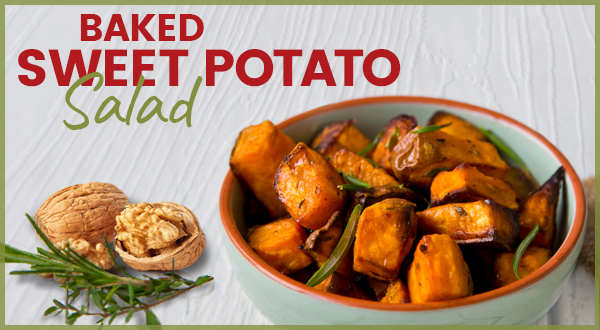
Sweet potatoes are also rich in beta-carotenes, which can enhance cytotoxic activity against lung cancer cells. Another ingredient, ginger, is an excellent source of the phytonutrient 6-gingerol, which stimulates antioxidant defenses and pharmacological pathways for healing.
This delicious salad is a comfort food that rejuvenates, satisfies, and can be eaten cold in the summer or served warm for fall and winter meals. You can find the recipe here.
Black Bean Hummus
Dips are a favorite among snack fans (and perfect for all the football lovers out there), so we like to include a delicious black bean hummus at our house. This power hummus is a delicious dip for veggies, and makes for a stunning appetizer when served on whole grain or gluten-free bread or toast. (It can also be savored as a hearty sandwich spread if you have leftovers.)
Black beans are the foundation of this spread, and offer a plethora of health benefits. From bone health to digestion, there are plenty of reasons to love these legumes. But perhaps the greatest benefit is the presence of selenium.
Selenium is known to prevent cancer, working to detoxify, reduce inflammation, and maintain a healthy balance of reactive oxygen species. Among the ingredients are chickpeas, which can modulate cancer risk; and garlic, which represents a whole pharmacy industry due to its broad spectrum of effects.
For a healthy snack that fights cancer and promotes overall health, you don’t want to miss out on this recipe.
Broccoli Sprouts Dip
Broccoli sprouts top the list for anti-cancer superfoods. They contain 50 times the cancer fighting power of mature cruciferous vegetables and are loaded with enzymes for digestion, metabolism, and detoxification.
Combined with hemp seed oil, turmeric, garlic, onion, and pumpkin seeds, this broccoli sprouts recipe is a nutrient dense, cancer annihilating, inflammation decreasing treat for those battling cancer or actively working to prevent it.
The added black pepper and sea salt increase the rate of nutrient absorption and enzyme activity so the body can get busy detoxifying and rebuilding damaged tissue while restoring the immune system. You can get the recipe here.
Sides
We get that the turkey is considered the main event, but at the Bollinger house, sides are KING. But all those starchy, buttery, sugary extras can really mess with your body’s natural balance and even promote cancer cell growth.
That’s why we keep the focus on hearty dishes that work with your body instead of against it. Here are a few of our favorites…
Healthy Cranberry Sauce With Orange & Cinnamon
A holiday feast is just not the same without pretty cranberry sauce to brighten the table. Canned cranberry sauce can’t compare taste-wise or nutrition-wise to homemade, but the downside is that most cranberry sauce recipes use A LOT of sugar.
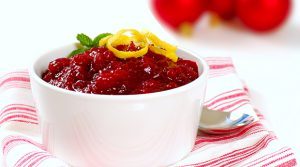
Check out my recipe here.
Detoxifying Cauliflower, Kale, and Pine Nut Confetti
Humble cauliflower is often overlooked as a leading member of the cruciferous family, but it’s actually one of the healthiest foods on the planet. It boasts a rich supply of health-promoting phytochemicals, anti-inflammatory compounds, and other cancer-busting nutrients.
Importantly, cauliflower supports digestion and detoxification. This is due to its sulfur-containing compounds, known as glucosinolates. These compounds break down in your stomach into byproducts during digestion, supporting efficient nutrient absorption as well as toxin and waste removal.
This delicious side dish also features kale, another superstar cruciferous veggie that provides glucosinolate compounds in addition to vitamins A, C, K, anti-inflammatory omega-3 fatty acids, and calcium. Like cauliflower, kale is filled with fiber and sulfur, both great for detoxifying your body and keeping your liver healthy.
Last, but definitely not least, pine nuts help suppress appetite as they contain pinolenic acid, which triggers the release of appetite-suppressing hormones. They are also very high in protein… Just 1⁄4 cup provides 8 grams of protein! Check out the recipe here.
Artichoke and Roasted Tomato Flatbread
Whether they are red, yellow or purple, tomatoes are a rich source of many nutrients such as vitamin C, vitamin E, vitamin K, potassium, copper, manganese, folate, and fiber.
It is a particular kind of carotenoid called lycopene that gives tomatoes their cancer-fighting edge, however. A 2005 Canadian study found that “a diet rich in tomatoes and tomato-based products with high lycopene content may help reduce pancreatic cancer risk.”
Other antioxidants such as alpha-lipoic acid, choline, beta-carotene, and lutein provide even more nutrition and protection against disease. Finally, tomatoes only have about 32 calories per cup, making them a good choice for those who want a healthy way to reduce calories.
Unlike many antioxidant-rich foods, tomatoes are still beneficial when they’ve been processed. Canned tomato products, tomato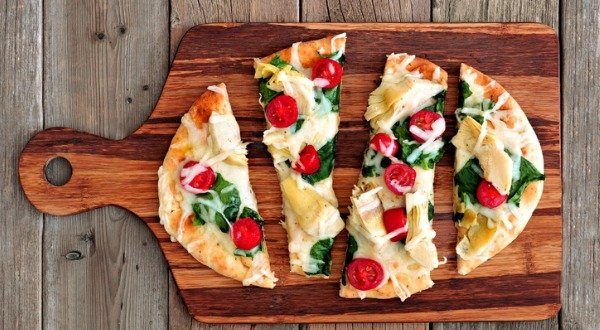
That being said, some tomato-based products like pasta sauce and ketchup are notorious for being very high in sugar, especially high fructose corn syrup. Be sure to check the sugar and additive content in these products especially.
Fresh artichokes are absolutely brimming with both flavor and disease-fighting antioxidants this time of year. According to research published in the Nutrition Journal, they actually contain more antioxidants than almost any other vegetable.
Antioxidants like rutin, quercetin, silymarin, and gallic acid have also been shown to prevent cancer. Artichokes are also loaded with prebiotic fiber, which can help with detoxification AND fight diseases like Lyme.
There are millions of ways to prepare and serve these cancer-fighting foods, but one of my all-time favorites is in my artichoke and roasted tomato flatbread. You’ll definitely want to save this recipe.
Desserts
No matter how much food you prepare for Thanksgiving, it seems that everyone is somehow still ready for dessert. And this is where you can REALLY find yourself in nutritional trouble. Most of the cakes, pies, and cookies that have become synonymous with the holiday season are made almost exclusively with refined sugar and bleached flour.
Whether you are currently healing from a type of cancer such as breast cancer or prostate cancer, or are simply trying to maintain good dietary principles, I personally recommend that you avoid white sugar, brown sugar, agave, and all artificial sweeteners such as aspartame, sucralose, and saccharin. If you have a sweet tooth, it’s best to stick with 100% organic green stevia, xylitol, raw honey, pure maple syrup, molasses, and coconut sugar.
But fear not! We’ve got you covered with some mouth-watering desserts that are sure to become a new staple in your home.
Gluten-Free Pumpkin Pie
Can you even have Thanksgiving without pumpkin pie? Most pies you find at the store are chock-full of sugar, but this healthier version blends pumpkin and butternut squash for its nutrients and flavor. Pumpkin and squash are loaded with carotenoids that are powerful, cancer-fighting nutrients with many other benefits.
Nutritionists recommend consuming controlled quantities of complex carbohydrates rich in dietary fiber to lower your risk of prostate cancer. Foods like pumpkin and butternut squash (as well as quinoa, sweet potato, and bananas!) help give your body the minerals it needs to remain healthy and disease-free.
Next, a 2012 study published in the Asian Pacific Journal of Tropical Medicine demonstrated how the antioxidants found in nutmeg may help to prevent the formation of blood vessel systems that feed cancer tumors. We’ve added cinnamon as well as it acts as a potent blood thinner, making it an excellent natural remedy for maintaining heart health.
The cashews add creaminess and are also concentrated with protein, digestive enzymes, magnesium, and antioxidants. They are especially good for fighting colon cancer. This pie is gluten- and dairy-free with healthy omega-3 fatty acids so you can enjoy this dessert on special occasions without the guilt! See the recipe here.
Almond Goji Brazil Nut Cookies
Brazil nuts are very high in omega-3 fatty acids, carotenoid antioxidants, and selenium, an anti-cancer mineral and thyroid regulator. Goji berries are noted for their lycopene, which has antioxidant properties and anti-inflammatory effects. Almonds are a most nutritious complete protein, rich in magnesium (the free radical fighter), making it a preventative food against cancer.
These delicious cookies also include two cancer cell killers: turmeric and vitamin B17 (also known as laetrile or amygdalin). Click here for the recipe.
Maca Cacao Chocolate Pie
There are special times of the year when it seems that everyone around you is chowing down on boxes of chocolates and other sugar-filled treats. You don’t want to throw your healthy anti-cancer eating plans out the window, but you really want to join in and enjoy something sweet. This recipe for Maca Cacao Pie is one of my favorite go-to recipes that’s perfect for just these types of situations.
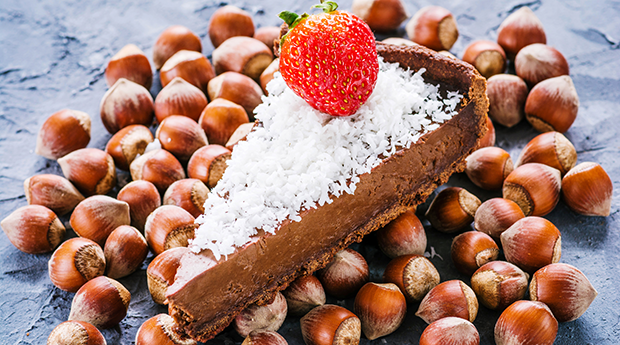
Organic raw cacao powder is exceptionally rich in magnesium, vitamin C, and immune-boosting enzymes. Cacao powder is made from cold pressing unroasted cocoa beans which maintains the living enzymes that contribute to good gut health.
Chia seeds may be tiny in size, but are packed full of nutrients and contain natural antioxidant properties. Chia seeds are also a good source of dietary fiber, omega-3 fatty acids, and complete proteins. Not to mention being one of the best plant-based sources of zinc.
Maca is an immunostimulatory, energizer, mood enhancer, and stomach cancer fighter. If you’ve not used maca before, you can find it at most health food stores and specialty food stores such as Whole Foods and Trader Joe’s.
These three super foods, combined with the remaining healthy, anti-cancer ingredients such as raw nuts, flaxseed, and coconut oil make this dessert both delicious and therapeutic… the perfect chocolate treat for your holiday gatherings. Get the recipe here.
The Bird
Learning to properly roast a turkey is a rite of passage in my family, which is why making sure to maximize the nutritional value is so important. Luckily, turkey is already a pretty healthy meat and an excellent source of lean protein…
For every 4 ounces of turkey there are about 32 grams of protein. Plus, your body has to work harder to digest the protein, so it will burn a few more calories along the way. If you are worried about cholesterol levels then turkey is your bird. Turkey has less saturated fat than other more fatty meats making it an ideal addition to your dinner plate. Turkey also has selenium which boosts thyroid and immune function as well as supporting several antioxidant functions.
The herbs and spices you use to season the bird are also very important. Here are some of the best cancer-fighting spices you may want to try:
Turmeric
Turmeric contains a compound called curcumin, which studies have shown to have powerful anti-inflammatory properties and is widely believed to promote optimal liver function.
In addition, there are hundreds of scientific studies demonstrating how curcumin inhibits the growth of various cancer cells including colon, liver, pancreatic, bladder, stomach, kidney, blood (leukemia), prostate, ovarian, bone, brain, breast cancers, and even skin cancer. Curcumin triggers apoptosis, or programmed cell death, which is the body’s natural and necessary way of ridding itself from damaged cells.
Cayenne Pepper
A powerful antioxidant called capsaicin can be found in cayenne pepper and other hot peppers including habanero, chipotle, jalapeno, Anaheim, ancho, and Scotch bonnet peppers. Capsaicin has been shown in several laboratory studies to be toxic to cancer cells.
A study conducted by the American Association for Cancer Research reports that capsaicin is able to kill prostate cancer cells by forcing them to undergo apoptosis without harming healthy cells.
Another study in 2007 at the University of Nottingham in the UK found that capsaicin killed laboratory cultured lung cancer cells and pancreatic cancer cells. Researchers reported that capsaicin did no harm to surrounding tissue. An earlier study in 2002 found capsaicin effective in inhibiting the growth of adult T-cell leukemia cells through the induction of cell cycle arrest and apoptosis.
Oregano
Oregano is extremely antimicrobial, high in antioxidants, and has been shown to be a powerful parasite fighter as well as a cancer inhibitor. Ounce per ounce, fresh oregano has been shown in a study by the U.S. Department of Agriculture to have higher antioxidants than fruits and vegetables. For example, one tablespoon of fresh oregano was found to contain the same antioxidant activity as a medium-sized apple.
A beneficial phytochemical called quercetin is present in oregano and is known to slow cancer growth as well as promote apoptosis. Oregano also possesses a very special molecule called carvacrol. Carvacrol is a natural disinfectant that stifles the spread of cancer cells. Other herbs that contain carvacrol are thyme, basil, parsley, marjoram, and mint.
When foods are marinated using oregano (along with other ingredients), it helps to reduce the development of heterocyclic amines (HCAs). When meat and other fatty animal foods are cooked at high temperatures, HCAs can form which are carcinogenic.
Garlic
Garlic belongs to a family of vegetables called alliums which also includes onions, leeks, chives, shallots, and scallions. These vegetables are clinically proven to have antimicrobial, antithrombotic, and antitumor applications.
The most recent research into alliums has focused on their potential anti-carcinogenic influences. Garlic has been demonstrated in studies to lower the risk of developing stomach, colon, prostate, and intestinal cancers. Garlic stops cancer cells by blocking the formation of and halting the activation of cancer-causing substances. Garlic is a strong antibacterial agent and has been shown to speed up DNA repair, kill cancer cells, and induce apoptosis.
When preparing garlic, it is best to let it sit for 5-10 minutes after slicing, chopping, crushing, or mincing. This is because garlic contains two enzymes (alliin and alliinase) that are separated when the garlic clove is whole.
When the cells are ruptured (through cutting, chopping, etc.) these two enzymes interact to form a new compound called allicin which has cardiovascular, antibacterial, and anti-cancer benefits. Allowing the cut garlic to sit for several minutes before adding other ingredients will increase allicin production.
General Culinary Suggestions
As always, the source of your food is nearly as important as what kind of food you choose in the first place. From turkeys and tomatoes to pumpkins and pecans, it’s essential that you find organic, non-GMO products.
GMOs (or genetically modified organisms) are living organisms – like fruits and vegetables – that have been artificially manipulated through genetic engineering. The technology was developed primarily to make crops resistant to toxic herbicides and pesticides but is now used to create crops that are bigger, brighter, and brown-resistant. The food you buy at the grocery store is nothing like food that’s grown naturally.
Due to a severe lack of safety studies, there is no evidence proving that GMOs are safe for consumers. The biggest risk is the presence of harmful pesticides and herbicides, which have been shown to cause cancer and other harmful side effects. Although more than 60 countries require GMOs to be labeled (including the entire European Union), the United States has had no such requirements.
It’s also important that you look out for the type of packaging used in your foods. When plastic is heated, it releases toxic fumes, which can also be absorbed by your food. Canned goods are packaged in tin, aluminum, and steel that can break down and leach into food over time. Many canned goods are also lined with bisphenol A (BPA) – a cancer-causing agent found in plastic resins and thermal papers. Opt for frozen vegetables over canned and look for “BPA-free” products.
No matter what you end up serving this year, we wish you and yours the happiest of Thanksgivings!










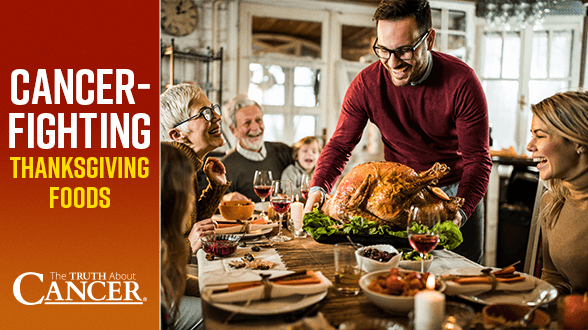








Thank-you for all the research you do to help us stay healthy. I am 82 and appreciate what you are doing for all of us who are awake. Keep up the good work
.
Very interesting about the garlic too thank you
THANK you so much for the information,God bless us all💖💖💖